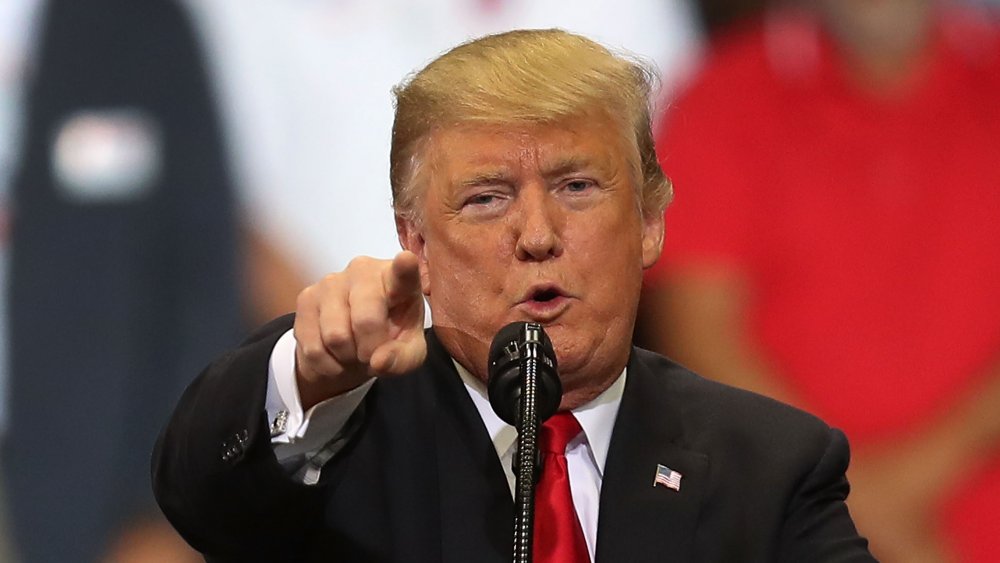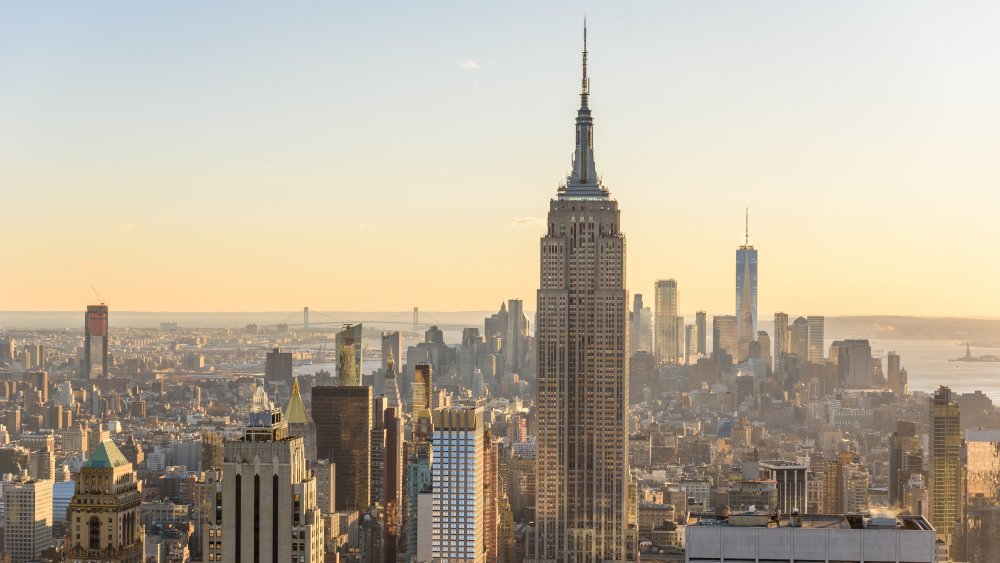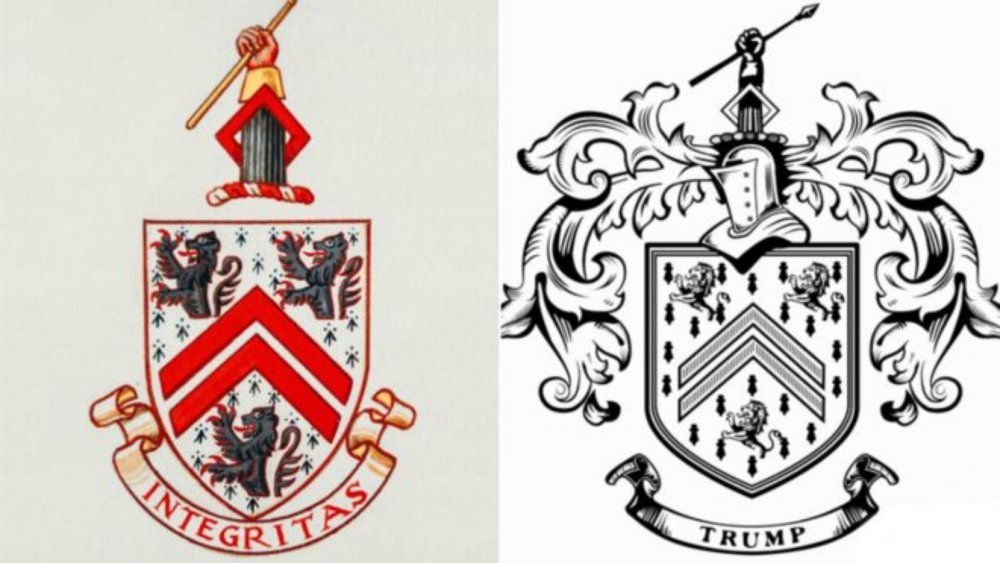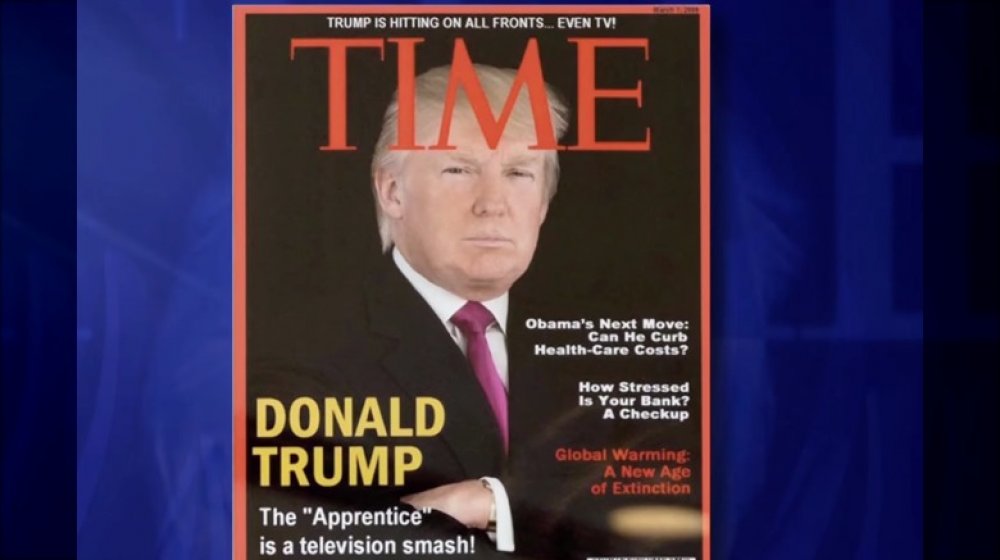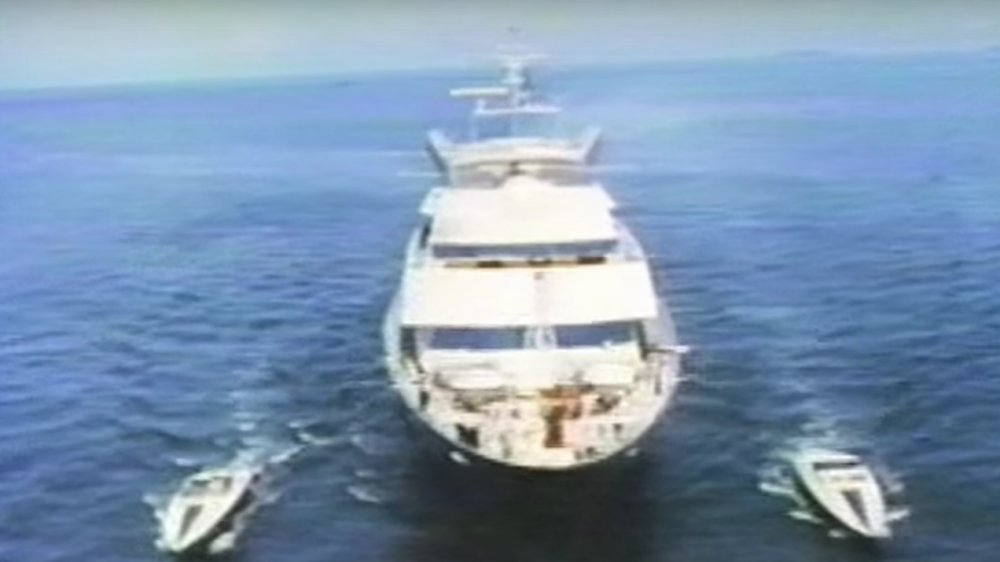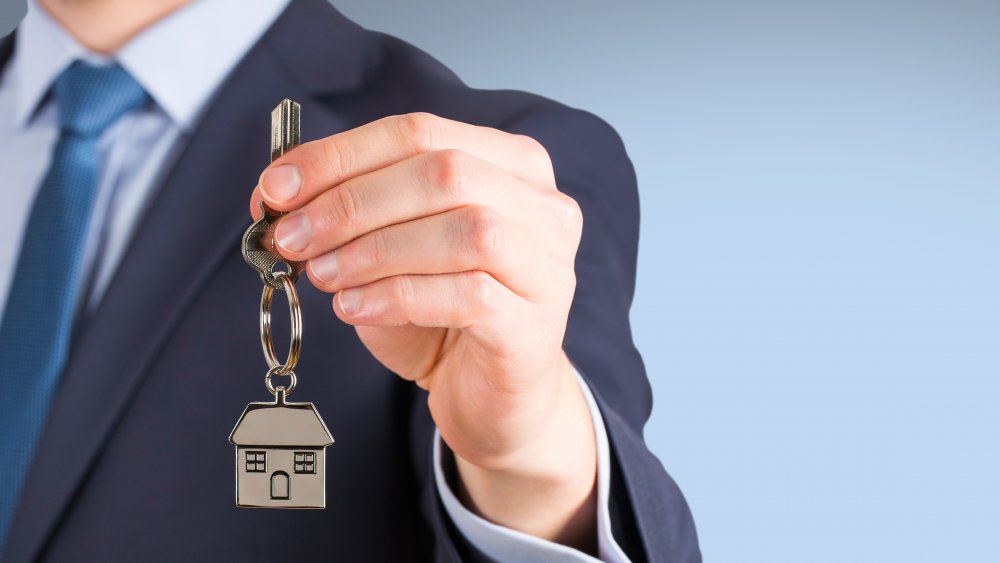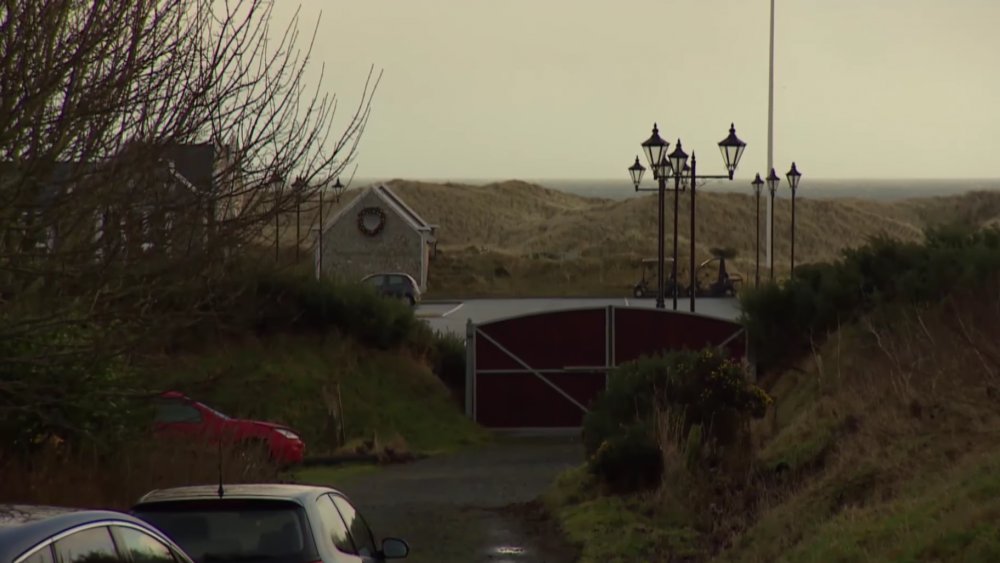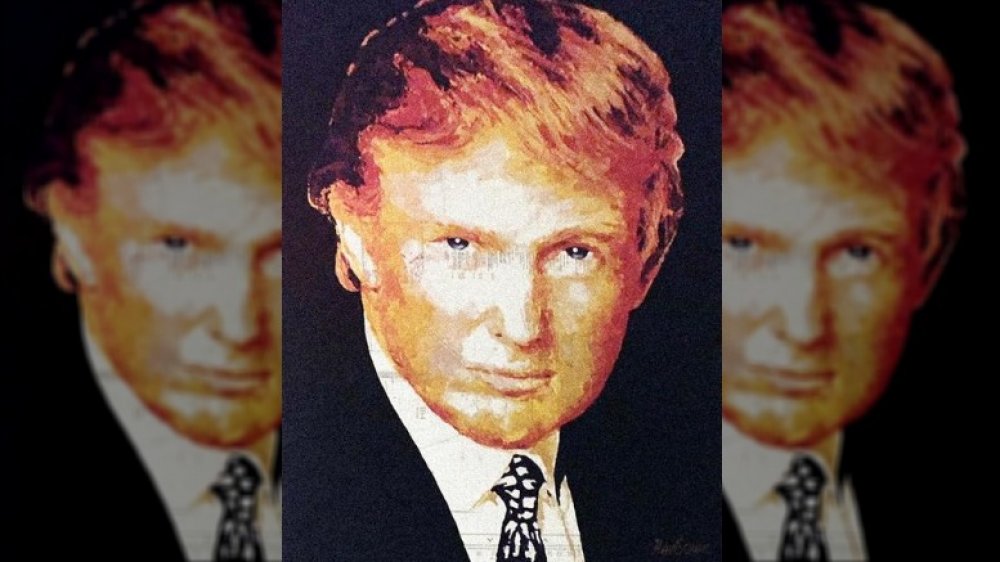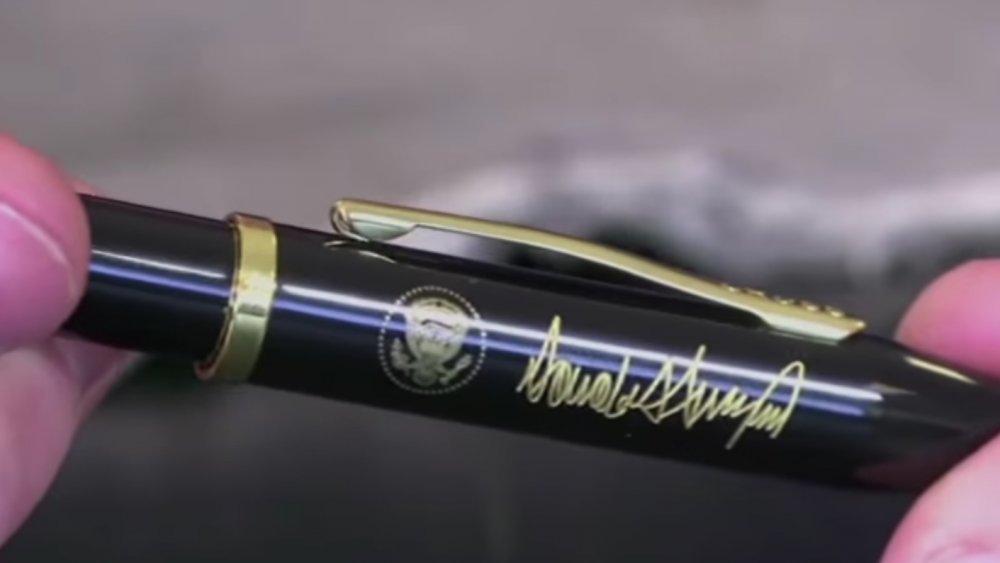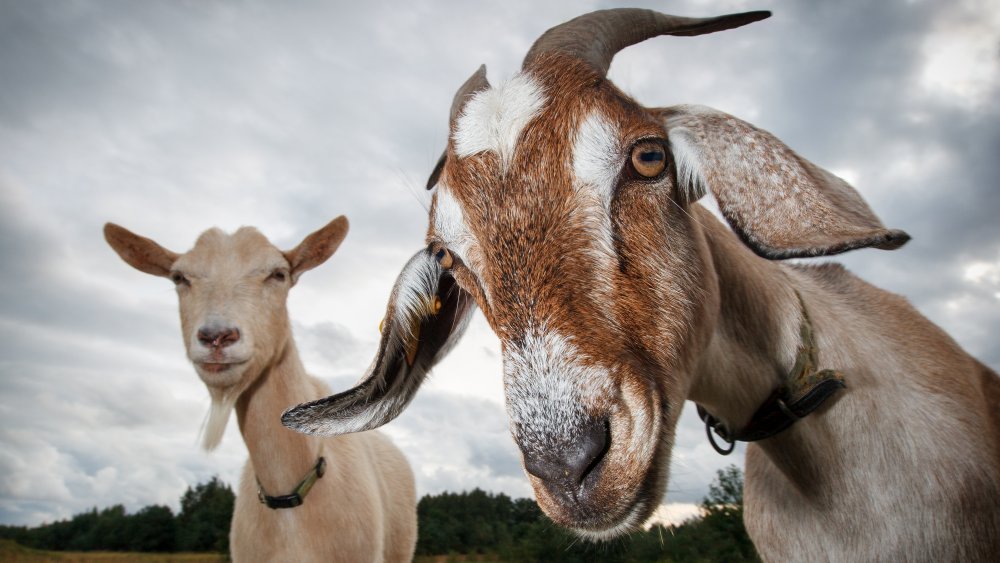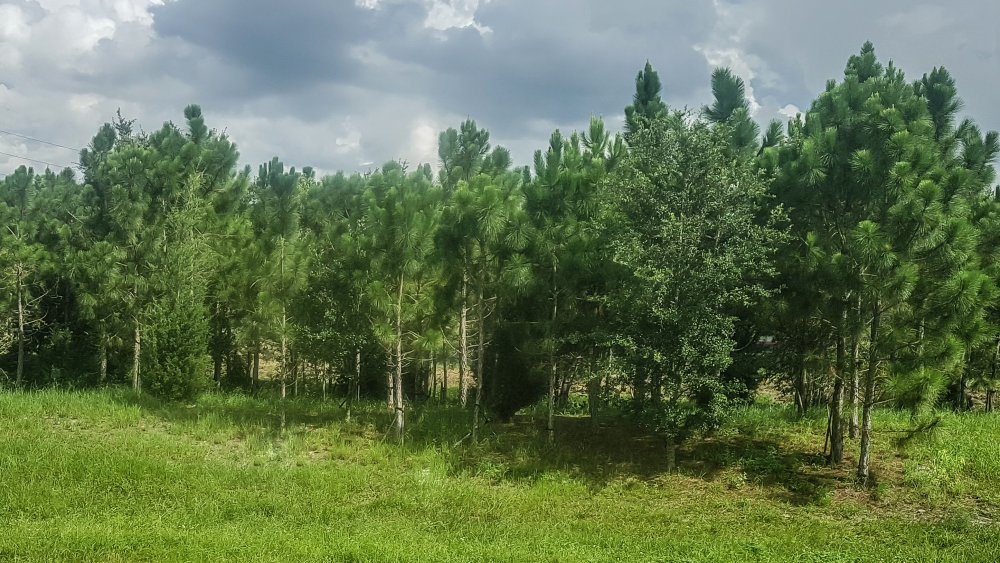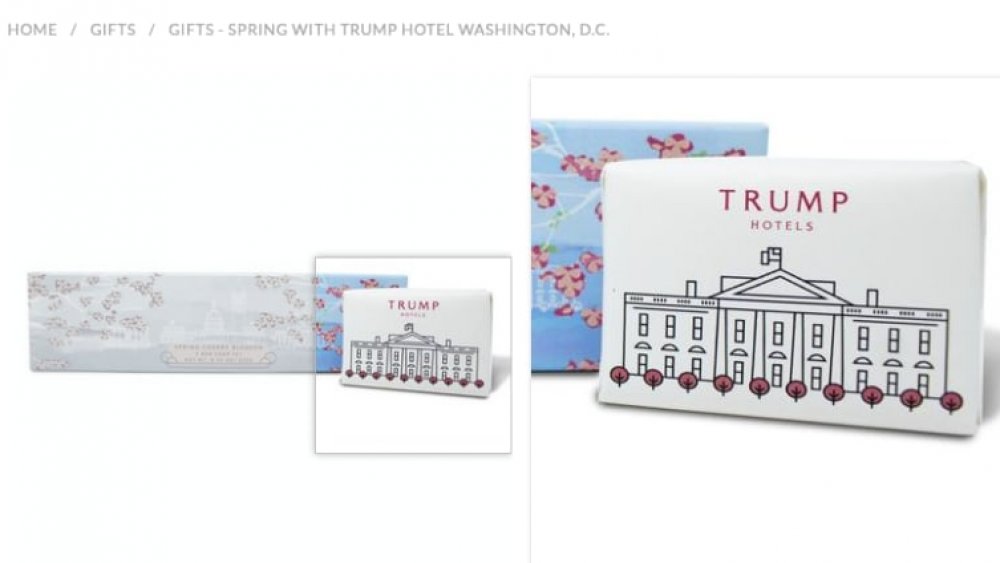The Most Bizarre Things Donald Trump Has Ever Owned
December 18, 2019 left an indelible mark on Donald Trump's presidency when the House of Representatives voted to impeach Trump for abuse of power and obstruction of Congress. As the impeachment debate raged, many head-turning statements were made. Republican Congressman Barry Loudermilk compared Trump to Christ prior to his crucifixion, claiming, "Pontius Pilate afforded more rights to Jesus than Democrats have afforded this president." And at a campaign rally in Michigan, President Trump implied that the late WWII veteran and Michigan congressman, John Dingell, was in hell "looking up" at his wife, Democratic Congresswoman Debbie Dingell. While that day will shape Trump's legacy moving forward, back in earlier days, he was better known for owning things.
As the star of The Apprentice, Trump owned contestants metaphorically, firing them on national television. As a presidential candidate he boasted a Boeing airliner with 24-karat gold-plated seat belts and gold-plated bathroom fixtures, per Business Insider. And the Oregonian reports that before moving into the White House Trump resided in a penthouse with a gold and diamond-encrusted front door and architectural elements inspired by King Louis XIV. Over the years, he has also owned a host of surprising, bizarre, or hard-to-explain things. Here are some of them.
Donald Trump snagged half of the Empire State Building for free
Everyone remembers when King Kong almost conquered the Empire State Building. But in a story that's even more bananas, Donald Trump "almost got the Empire State Building as a freebie," according to former real estate judge Edward Lehner. Crain's New York Business explains that in 1961, developers Harry Helmsley and Larry Wien acquired the Empire State Building and later finagled an arrangement with Prudential Insurance Co. of America that transferred ownership to Prudential and allowed the developers to pocket the profits from running the property until 2076.
Eventually, Prudential sold the building to Japanese billionaire Hideki Yokoi, who was bound by the long-term lease. In 1994, Yokoi gave half of the building to Trump free of charge in hopes that Trump would successfully exploit the laws to nullify the lease and own the whole building. This was a huge boon for Trump, who had defaulted on roughly $1 billion of debt from other holdings. A triumphant Trump declared, "It solidifies my position as New York's Native Son."
Plus, Trump despised Harry Helmsley's wife, Leona, calling her "a disgrace to humanity," per the LA Times. In 1995, Trump sued the Empire State Building leaseholders, alleging that they made "a mess" and made it a "laughing stock," thus violating the lease. However, Judge Lehner found Trump's claims unconvincing. In 2002, Trump and his co-owner sold the building to the leaseholders.
Donald Trump allegedly stole his coat of arms
Originally worn on warriors' shields in the 12th century, coats of arms have come to denote nobility, says the BBC. In the UK, if you consider your family or affiliated organization eminent enough to boast a coat of arms, you should first petition for permission from the College of Arms. UK law forbids adopting another family's insignia. However, Donald Trump allegedly broke both of those rules.
The Trump crest came from an emblem registered in 1939 by US diplomat Joseph Edward Davies. Smithsonian writes that Davies' wife, Marjorie Merriweather Post constructed Mar-a-Lago during the 1920s and Trump purchased the Florida resort in 1985. Later, Davies' grandson, ex-US senator Joseph Tydings, noticed the copied coat of arms. Though a few embellishments were added, the most notable change was switching the text from "Integritas" (the Latin word for "integrity") to "Trump."
In the United States, Trump trademarked Davies' design and emblazoned it on merchandise, hotels, and golf resorts. However, as UPI describes, in 2008, Trump was censured by Scotland's heraldic authority for using his unregistered emblem to promote Trump International Golf Links in Scotland. In doing so he broke a Scottish law that had been in place since 1672. And since another family owned the crest, he didn't get approval from the UK College of Arms. So Trump altered the UK version of his crest and finally obtained approval in 2012.
Donald Trump's strange history of fake Time magazine covers
In 2019, Time named 16-year-old climate activist Greta Thunberg its Person of the Year, and 73-year-old President Donald Trump reacted by attacking her on Twitter. As Newsweek recounts, the POTUS posted an inflammatory tweet calling the decision "ridiculous" and accusing the teen of having an "anger management problem." His reelection campaign later tweeted a photoshopped version of Time's cover with Trump's head superimposed on Thunberg's body, accompanied by a list of the president's alleged accomplishments. But it wasn't the first fake Time cover designed to celebrate Donald Trump.
As NBC describes, in June 2017, Time magazine asked Trump's golf courses to take down bogus covers featuring Trump. The covers purported to be from a March 1, 2009 issue that proclaimed in all caps, "TRUMP IS HITTING ON ALL FRONTS ... EVEN TV!" and hailed his reality TV show, The Apprentice, as a "smash hit." According to Time, no such issue existed.
What makes this incident especially strange is that Time featured Trump on a 1989 cover and named him Person of the Year in 2016, giving him legitimate covers he could have used. The president added another layer of oddity when he tweeted that the publication called to say it would "probably" declare him Person of the Year for a second consecutive year in exchange for an interview and a "major photoshoot." Time denied requesting that favor, though.
Donald Trump bought a superyacht from Jamal Khashoggi's uncle in the 1980s
When Donald Trump purchased one of the biggest yachts on the planet in 1987, he didn't even seem to like yachts. In 1989, Boat International quoted Trump as saying, "I'm not into them. I've been on friends' boats before and couldn't get off fast enough." In fact, when he coughed up nearly $30 million for the 282-foot (86-meter) Benetti superyacht, he didn't bother to board the behemoth first.
It was Earth's eighth largest yacht, according to Business Insider and had previously appeared in the 1983 James Bond movie, Never Say Never Again. Trump explained that the boat had "a certain level of quality," hailing it as "the ultimate toy." Strangely, an old video clip from what sounds like an episode of Lifestyles of the Rich and Famous also described this exact same yacht as "the ultimate toy" before it came into Trump's possession. That's not even the strangest part of this whole story. Trump acquired his aquatic colossus from Saudi Arabian arms dealer Adnan Khashoggi.
If that name sounds familiar, that's because it is. NPR identifies Adnan as the uncle of Washington Post journalist Jamal Khashoggi, who was brutally slain at a Saudi consulate in Istanbul in 2018. Trump claimed that he received a $1 million discount for the yacht for agreeing to change the yacht's name. It had been named Nabila after Adnan's daughter. This ultimate toy was redubbed Trump Princess.
Donald Trump's $0 mansion
In 1987's Trump: The Art of the Deal, Donald Trump declares, "Deals are my art form. Other people paint beautifully on canvas or write wonderful poetry. I like making deals, preferably big deals." In 2008, Trump illustrated that he could artfully dodge paying a great deal of money for 10,400-square-foot mansion in Beverly Hills. On paper, he didn't pay anything.
As detailed by Reveal from Center for investigative Reporting, the massive mansion sat next door to one that Trump already owned. Alleged Egyptian fraudster Mokless Girgis bought the property for $10.3 million, and financial records show that six weeks later, he transferred it to Trump via a shell company for the low, low price of $0. A year later, Trump sold that same mansion for $9.5 million.
Girgis blamed the anomalous transaction on a clerical error, claiming his name had been erroneously placed on the deed to the mansion, necessitating the $0 price tag. Reveal from the Center for Investigative Reporting consulted five real estate lawyers on the matter. None of them had ever seen such an enormous error, and given Trump's many real estate deals, it struck them as an especially glaring error to overlook.
Donald Trump's Scottish 'border wall'
If you look up "border wall" in the dictionary, on the other side of it you'll find a picture of Donald Trump. He famously proclaimed on the campaign trail that Mexico would pay for a wall on the US southern border, much to the delight of his supporters. As Politico recounts, in late 2018, the president was so adamant about building it that when Congress refused his demand for $5 billion in border wall funding, Trump refused to fund the government just days before Christmas, kicking off a 35-day government shutdown. It's currently the longest government shutdown in U.S. history. And Yahoo News reports that when the White House hosted a Halloween party in 2019, "children were encouraged" to make a paper border wall mural. Apparently, Trump believes in border walls so much that he also built one in Scotland.
The BBC explains that in 2006, Trump purchased an erstwhile shooting estate located north of Aberdeen. He planned to expand his land into a luxurious 1,500-acre golf resort. Unfortunately for Trump, some local residents saw his vision as a bad idea. David and Moira Milne refused to make room for the resort. Trump tried to buy their home, but they wouldn't budge. So the Trump Organization constructed "earthen walls" on two sides of the Milnes residence, according to the CBC, and then tried to bill the couple for half the costs. The Milnes responded by flying a Mexican flag, though technically, Trump's the immigrant.
Donald Trump's charity purchased a $10,000 portrait of him
In 2019 a New York court ordered Donald Trump to pay $2 million to various charities as punishment for misusing his own. According to Reuters, a 21-month investigation revealed "extensive unlawful political coordination." For instance, in 2007, the Trump Foundation used $100,000 to resolve a legal dispute at Donald Trump's private resort, Mar-a-Lago. The charity didn't even have employees and "had never written a required protocol for disbursing funds."
Trump vehemently denied wrongdoing. However, the Associated Press points out that the president's own legal filings appeared to contradict him. By his own admission, Trump spent $11,525 in charity funds on sports memorabilia and champagne. In violation of the law, Trump's charity coordinated with his 2016 presidential campaign to hold a fundraiser for veterans before the Iowa caucuses. In perhaps the strangest chapter of the scandal, the Trump Foundation spent $10,000 on a ginormous portrait of Donald Trump (above).
As Newsweek details, the 6 foot tall portrait of Trump was put up for auction at Mar-a-Lago in 2014. The proceeds from the sale would go to the Unicorn Children's charity, but buyers were rarer than unicorns. No one wanted it, so Trump bid $10,000. When no one else took it, he billed his own charity to cover the cost. Afterward the work vanished, but Univision anchor Enrique Acevedo tracked it down and found it at Trump's Doral resort in Florida.
Donald Trump's customized Sharpies
The pen is mightier than the sword, but for Donald Trump, the Sharpie cuts through both of them. As Business Insider describes, the president uses Sharpies to sign executive orders and scribble notes on speeches. Speaking with Axios for a four-part HBO series, Trump sang the Sharpie's praises and slammed the standard pen implement used by his Oval Office predecessors. "It was a horrible pen, and it was extremely expensive," Trump complained.
He lauded the Sharpie because it "writes much better and this cost almost nothing." "So, I called up the folks at Sharpie," Trump recalled, "and I said, 'do me a favor, can you make the pen in black? Can you make it look rich?'" It's unclear how much it costs to make Sharpies look rich, but a 2017 video from the Associated Press explains that they're gold-plated and engraved with Trump's signature.
Trump's love affair with Sharpies goes way back. As the Guardian describes, in 1999, Trump took a copy of an interview he had with the New York Times, wrote a note across it in Sharpie, and sent it to Rudy Giuliani. Trump had written: "Rudy, you're the greatest, see you soon." In 2015, Vanity Fair editor Graydon Carter claimed that after calling Trump a "short-fingered vulgarian" more than 30 years earlier, Trump continually sent photos of himself on which he "circled his hand in gold Sharpie in a valiant effort to highlight the length of his fingers."
Old MacDonald Trump had a farm
Donald Trump doesn't seem particularly fond of animals. His ex-wife, Ivana, recalls in her 2017 memoir, Raising Trump, that "Donald was not a fan of dogs." When U.S. special forces took out ISIS Leader Abu Bakr al-Baghdadi, Trump declared that the terrorist "died like a dog. He died like a coward." And an unnamed source identified as "a longtime adviser" to Trump alleged that when Vice President Mike Pence's family brought some of their pets (which consist of a snake, two cats, and a rabbit) to their DC residence, Trump "was embarrassed by it" and "thought it was so low class." Yet in an unexpected twist, one animal that might not get the president's goat is an actual goat.
Based on findings by the Wall Street Journal, Business Insider reports, that in 2016, a herd of goats lived on two New Jersey golf courses owned by Donald Trump. These bleating ungulates allow the president to claim a farmland tax break in accordance with state law. Of course, golf courses aren't farms, but in Trump's case, parts of them are. One hundred thirteen acres of the Trump National Golf Club in Bedminster are set aside for hay farming and eight goats. At his course in Colts Neck, 40 acres are set aside. Thanks to this set-up, instead of paying $80,000 or so in property taxes, Trump paid less than $1,000.
Donald Trump's mysterious plot of swampland
"Drain the swamp" became a popular mantra of Donald Trump's 2016 campaign. Obviously, he was referencing a political swamp because as of 2017, Trump owned literal swampland that remained undrained for years. As the Guardian details, in 2005 he acquired the quarter-acre plot of wetland in Florida for just $1. The previous owner was a woman who owned a photographic studio used for "adult lingerie shoots." However, even a scantily clad picture of Trump's swampland might be worth more than the property itself.
Situated in one of Florida's poorest areas, Trump's little slice of swamp was valued at $4,280 at the time of the Guardian's report. However, it generates zero income and is remarkably hard to access. No roads lead to it, and property appraiser Raymond MacIntyre explained that "you need a Jeep, a helicopter, or a parachute just to get to it." Despite leaving it "untouched," Trump has paid property taxes for it annually. In 2016, he paid $69.87. Seen against the backdrop of the jetsetter image Trump cultivated and his gaggle of golf course, it's unclear if or how this unprofitable swampland fits into the grand scheme of things.
Donald Trump's International Hotel sold White House-themed merchandise
Article II of the Constitution allots "a compensation" for the commander in chief but forbids sitting presidents from receiving "any other emolument" [i.e., fee, profit, or salary] from the US. Article I's foreign emoluments clause prohibits U.S. officeholders from "[accepting] any present, Emolument, Office, or Title, of any kind whatever, from any King, Prince, or foreign State" without the consent of Congress. As president, Donald Trump has decried the emoluments clause as "phony." But that hasn't stopped it from creating both real and utterly surreal controversies involving his businesses.
Politico reports that in October 2019, Trump begrudgingly scuttled plans to host the G-7 summit at his Florida resort, Trump National Doral Miami, over concerns about possible emoluments violations. Weeks before the Doral incident, Politico wrote that Congress was investigating allegations of emoluments violations at Trump International Hotel in Washington D.C. The property drew scrutiny after a foreign government and a domestic trade group apparently paid for a huge number of rooms and left them mostly empty in a possible attempt to "curry favor" with the president.
The foreign government in question went unnamed, but a financial disclosure report from 2018 shows that officials and lobbyists representing "the governments of Malaysia, Kuwait, or Saudi Arabia" booked rooms at Trump International Hotel in 2017, per USA Today. As detailed by the Washingtonian, the hotel drew harsh rebukes in 2019 for selling merchandise with images of the White House, which have since been removed.
